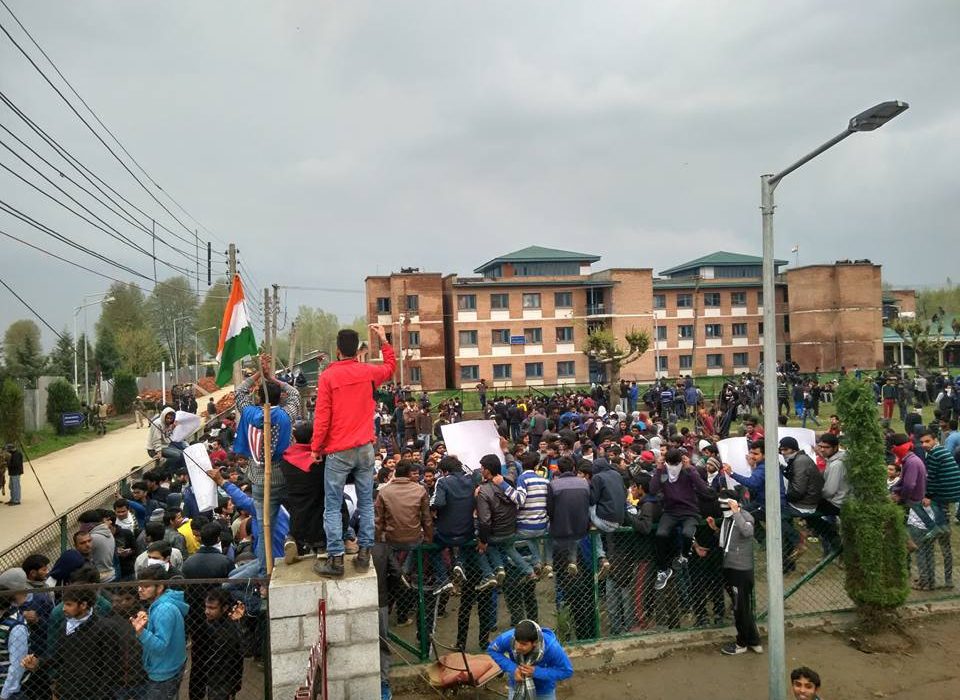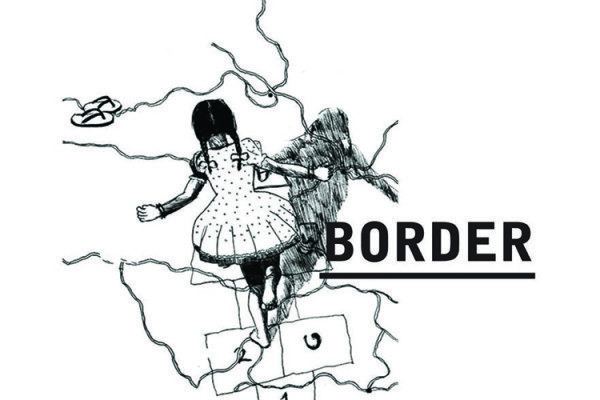There is nothing new either with Kashmiris cheering for the opposition when India play cricket or with the police in Kashmir using a lathi-charge to disperse protests, so enough with the selective outrage, says our correspondent.
Soon after Facebook began offering users the option of changing their profile pictures to reflect their favourite teams in the recent ICC World T20, Kashmiris, like other cricket-loving people, used this option widely. Throughout the tournament, they kept changing their profile pictures, from green when they supported Pakistan to black when New Zealand were playing, to other colours as well. On 31 March, however, their support was with the West Indies, who were playing their semifinal against India at Mumbai’s Wankhede Stadium.
Batting first, India posted 192 for two, with talismanic batsman Virat Kohli remaining unbeaten on 89. But India’s bowlers were unable to defend the total, losing the match by seven wickets and crashing out of a tournament everyone had been shouting from their rooftops they would win. There was jubilation not just in the West Indies camp, but also in the Kashmir Valley, where cricket is seen as a game only when Pakistan or India aren’t involved. When Andre Russell hit Kohli for a six, taking his team into the finals, hundreds of people throughout the Valley came out on to the streets, chanting slogans and bursting firecrackers, to celebrate India’s loss.
“When the dark and empty streets of your locality get instantly filled with jubilant people,” wrote one Facebook user. “Such is the level of hatred for them. Crackers.” Another wrote, “West Indies won the match and Srinagar is bustling with the sound of firecrackers. Anything that hurts India is a moment Kashmir awaits and cherishes.”
There was jubilation not just in the West Indies camp, but also in the Kashmir Valley, where cricket is seen as a game only when Pakistan or India aren’t involved.
There is nothing new in Kashmiris celebrating India’s loss in a cricket match. They have been doing so for decades, for reasons linked to the unresolved Kashmir conflict. It is a practice seen among oppressed people the world over, like the black South Africans who would cheer for the opposition whenever the Springboks played rugby during the days of apartheid. In any case, the notion that a nation can police which sports teams its people support is a fascist one.
“The celebrations in Kashmir on India’s loss is one of the many ways in which people demonstrate their resistance against the Indian state,” says Basharat Ali, a research scholar. “Since cricket has almost assumed the character of a ‘national’ and ‘nationalist’ sport in India, it becomes very essential, even if symbolically, for Kashmiris to come out in jubilation at the loss of the Indian cricket team.” Even when India played the West Indies on 12 October 1983 in the first international cricket match in Srinagar, the majority of spectators had cheered for the Windies.
“Kashmiri students not cheering for the Indian team,” acclaimed Kashmiri writer and journalist Basharat Peer said in a recent interview, “conveys the nature of the relationship between Delhi and Srinagar.”
Like in other parts of the Valley, Kashmiri students in the National Institute of Technology (NIT) Srinagar celebrated India’s loss, resulting into heated arguments between non-Kashmiri and Kashmiri students in the dining hall of the institute.
Established as a Regional Engineering College in 1960, students from the Kashmir Valley were a majority in the institute until it was converted into an NIT in 2003. The move altered the demographics of the campus; according to a report in The Indian Express, some 2,500 of the 3,000 students enrolled are from outside the Valley.
On 1 April, non-Kashmiri students staged a sit-in outside the director’s office, raising pro-India slogans and demanding action against Kashmiri students for celebrating India’s loss. They also raised the Indian flag in the campus, which was objected to by the Kashmiri students, leading to scuffles. According to eyewitnesses, students from both sides even threw stones at each other. Sensing trouble, the administration called in the police to disperse the students. Classes were called off until further notice.
Students from the Kashmir Valley were a majority in the institute until it was converted into an NIT in 2003. The move altered the demographics of the campus; some 2,500 of the 3,000 students enrolled are from outside the Valley.
However, the situation flared up four days later. The protesting non-Kashmiri students, who had raised several demands before the administration, tried to carry out a protest march outside the campus. They were stopped and lathi-charged by the state police at the campus gate. Scores of students were injured.
There is nothing new in the police using lathi-charge against students in Kashmir, but this was the first time that something like this had happened to non-Kashmiri students. The Jammu and Kashmir Police, which has been on the forefront of anti-militancy operations and curbing anti-India protests in the state for years, was not only labelled “anti-national”, but also removed from the campus and replaced by the paramilitary Central Reserve Police Force (CRPF). The Human Resources Development ministry rushed a three-member team—Sanjeev Sharma, Director (Technical Education) in the ministry; Fazal Mehmood, Deputy Director (Finance); and MJ Zarabi, Chairman of the NIT Board of Governors—to Srinagar in order to resolve the crisis.
Some senior police officers took to social media to vent their anger at being called anti-national. “Police action is not doubted when a student from any other institute is booked for breaking law,” wrote Firoz Yehya, Deputy SP at Baramulla, “but there’s controversy while we are dealing with students of a particular institute!”
Former chief minister Omar Abdullah told a national daily that such incidents have taken place after cricket matches for decades, and that authorities should have resolved the matter. By making it a larger story, and sending in central forces and a special team from the ministry, he said, the government had set a wrong precedent.
“J and K Police doesn’t need any certificate in nationalism from those whose valour doesn’t extend beyond their keypads,” wrote Mubassir Latifi, an SSP in the crime branch. “You beat a law enforcement officer for enforcing law. Better start your own police station inside the NIT and tell an engineering student to operate the kotwali.”
Former chief minister Omar Abdullah told a national daily that such incidents have taken place after cricket matches for decades, and that authorities should have resolved the matter. By making it a larger story, and sending in central forces and a special team from the ministry, he said, the government had set a wrong precedent. “Will we see calls to governors and CMs being deployed when Kashmiri students are harassed elsewhere? In Rajasthan recently, it were the Kashmiri kids who were instead arrested on charges of eating meat. How do you justify this uneven response for Kashmiri students and for non-Kashmiri students?”
The incident he referred to took place on 7 April, two days after the lathi-charge in Srinagar. A mob of 30 people attacked a group of Kashmiri students at the annual cultural event in Jodhpur’s Vyas Dental College. “Local students and outsiders, who had their face covered,” one student told The Hindustan Times, “chanted ‘Pakistan Murdabad’ slogans and looked for Kashmiri students at the function. They beat up every Kashmiri they found.” Another student added that the mob then “barged into our hostel rooms,” where some of them had taken refuge. “They attacked us with iron rods, sticks and knives, and threatened to kill us, saying they will take revenge for what happened in NIT Srinagar.”
This was not the first time Kashmiris studying outside Kashmir were attacked by fellow students or outsiders. The Hindustan Times has collated at least 30 such instances since February 2013 itself.
This was not the first time Kashmiris studying outside Kashmir were attacked by fellow students or outsiders. The Hindustan Times has collated at least 30 such instances since February 2013 itself. Neither have authorities rushed to their aid in such incidents. In the Jodhpur case, the director of the institute claimed all that had happened was that “[some] local students and ABVP workers shouted Bharat Mata Ki Jai and took photos.” At Mewar University in Chittorgarh, 16 students have been suspended for clashes following the match, though no action was taken against those who assaulted four Kashmiri students a month ago over allegations of cooking beef. (The four were themselves arrested instead, though released a day later.) On 5 March 2014, following India’s defeat to Pakistan in the Asia Cup, over 60 Kashmiri students were suspended for celebrating and charged with sedition, though the charges were dropped after outrage. Ten of them were later expelled.
The non-Kashmiri students have demanded the NIT be shifted out of Srinagar, that action be taken against the police who resorted to the lathi-charge, that the tricolour be hoisted on campus, that restrictions on their movement and celebrating festivals be removed. Though the administration has accepted most of the demands, the institute is unlikely to be shifted out of the state capital. “The HRD ministry is looking into the grievances of the outstation students, and I am hopeful it will be resolved soon,” said chief minister Mehbooba Mufti. “But as far as the demands of some students to shift the NIT campus out of Srinagar are concerned, let me make it clear that it will not be possible.”


